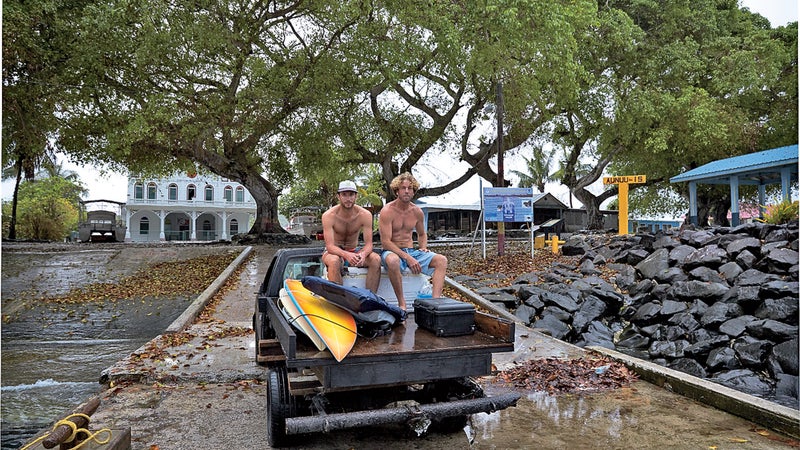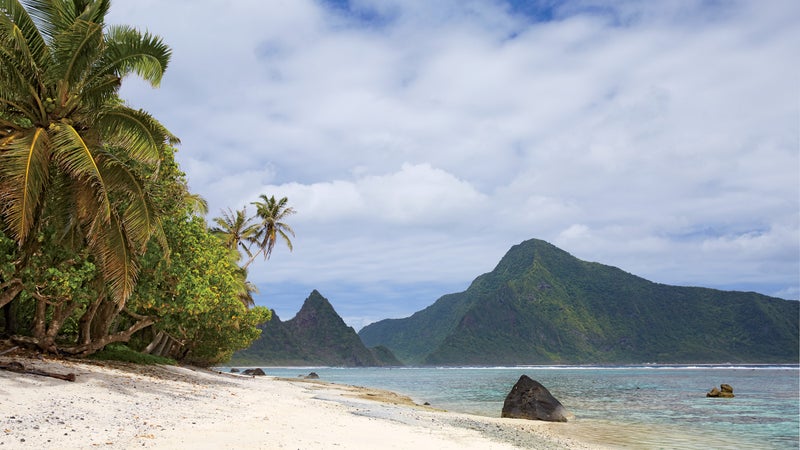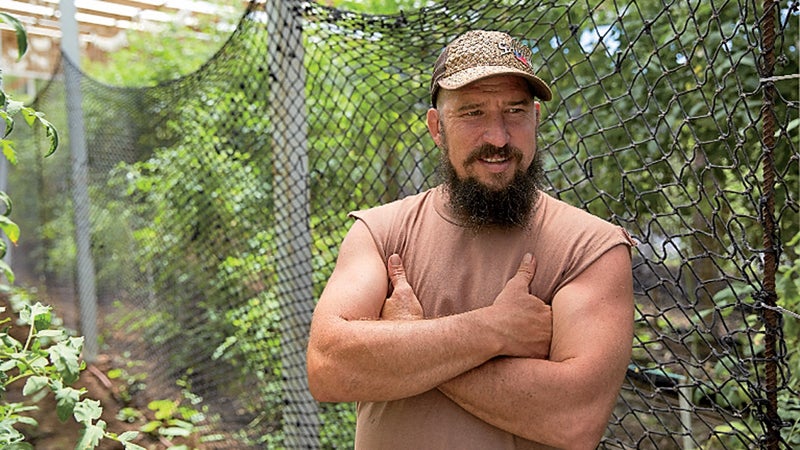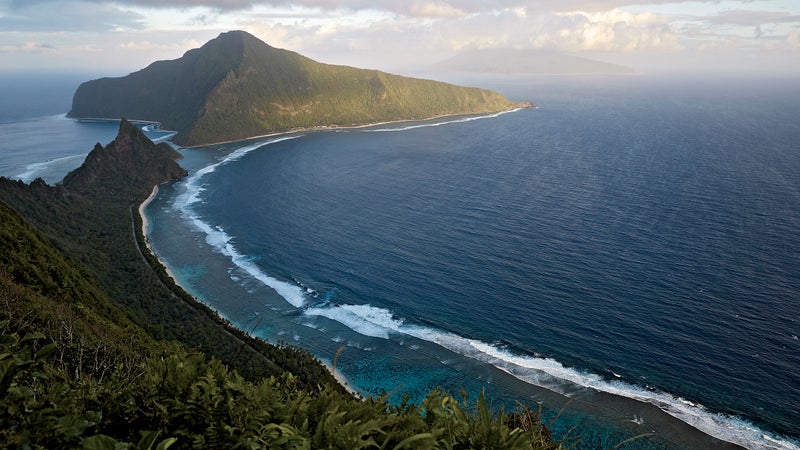Hunting for Surf in American Samoa
The rarely visited national park is home to tropical beaches, pristine coral reefs, some untapped surf, and not much else. Matt Skenazy went exploring and found a few good waves and a lot of mysterious South Seas mojo.
New perk: Easily find new routes and hidden gems, upcoming running events, and more near you. Your weekly Local Running Newsletter has everything you need to lace up! .
Dusty Snow's farm sits in the broad Malaeloa Valley, a mile from the coast, which is about as far as you can get here on Tutuila, the main island in American Samoa. It’s midday. The air is the same as it always is—syrupy and hot. Still, Dusty builds a fire of coconut shells to keep away the mosquitoes. A thickset man in his late thirties with a shaved head and scraggly beard, Dusty moved here three years ago from Long Beach, California. He sits in the shade of a hut built from the debris of a 2009 tsunami, cracks a third Coors Light, and sparks a fourth Marlboro.
“I’m a lucky guy,” he says, looking into the distance at nothing in particular and answering a question I didn’t ask. “I made the right choice. Fuck the rat race.”
We’re waiting for Michael Jackson, a 46-year-old expat who promises to help me find some surf. He’s running late, but before Dusty and I can continue talking about life choices, M.J. pulls up in a 12-passenger Econoline van. He has hair the color and kink of uncooked ramen, blue eyes, and tan, crispy skin. He gets out and shakes my hand.
I spread a map on the table next to the fire. “There are 25 established waves here,” he says. “On any given day, seven of them are world-class. There’s a wave here, here, here, here, here…”
American Samoa is a string of five islands and two atolls halfway between Hawaii and New Zealand. It’s known for its tuna canneries, its large deep-water harbor in the capital of Pago Pago, and exporting large men to the U.S. military and the NFL. Pago, as it’s called, is also the most densely populated town on the island, with 11,000 people filling colorful, one-story cement houses that rise on terraces near the water. The speed limit is 20 miles per hour, and it’s easier to buy $2 flip-flops than a fresh tomato.
American Samoa is not associated with great waves. Or any waves, really. The independent nation of Samoa, just 50 miles west, has a dozen surf camps. American Samoa has none. The reef here is said to be some of the shallowest and sharpest in the South Pacific. Counting M.J. and Dusty, only eight surfers, most expats, live in American Samoa. Which is exactly why photographer Kanoa Zimmerman and I are here.

We want to find surf in the National Park of American Samoa, one of the few parks in the system containing any coastal waters and the only one south of the equator. The park is spread out over three islands: the main portion, on Tutuila, is on the north coast and lacks the fringing reef generally required for good tropical waves. So we’ve got our sights on the outer islands, where there are park enclaves on a couple of reef-lined southern coasts. But our flight doesn’t leave for two days. So here we are.
“I grew up near the beach at Pipeline,” M.J. says, “and I’ve traveled all over the world, but I found a wave here that is the closest thing to Pipeline I’ve ever seen.”
Telling someone you found the next Pipeline is like telling someone you found the next Grand Canyon. It’s ridiculous. Kanoa also grew up in Hawaii. He and I give each other sideways looks. Still, we nod our heads.
M.J. moved to American Samoa in 2010 to work as an observer for the National Oceanic and Atmospheric Administration on long-line fishing vessels. His job was to record catch and bycatch data, making sure that the boats weren’t accidentally pulling in too many sea turtles or dolphins. He spent 86 days at sea without a port stop, which for a while was a NOAA record. But after being on five consecutive boats overrun with bed bugs, he called it quits. Now he’s working to open the territory’s first surf camp.
“So what’s the plan?” I ask.
“You can only surf here just before or just after high tide,” M.J. says. “Otherwise it’s way too shallow. In a minute we’ll head over to the same spot we surfed yesterday. It was about six- to eight-foot. And sheet glass.”
I find this hard to believe. For the past two days, Kanoa and I have driven circles around the island. We’ve gotten skunked. The southeast trade winds are unseasonably strong, ruining all the waves on the south coast, and a solid-seeming north swell has failed to materialize. We didn’t come looking for perfection—after all, there may be a reason there aren’t any surf camps here. But we expected something from an island that gets battered on all sides by Pacific storms.
Twenty minutes later, we’re tailing M.J.’s van along the southern coast. Dusty, in his Kawasaki Mule, isn’t far behind. The surf looks terrible—small, crumbly, shallow, whitecapped garbage. But according to M.J.’s map, we’ve already driven past three world-class waves.
“There’s Pipeline,” Kanoa says as we pass a break in the reef that looks exactly as bad as the rest of the coast. The villages we pass are full of stray dogs and pickup trucks. Eventually, the road turns inland and up, climbing a 25-degree rise at the far west end of the island. After cresting the ridgeline, we turn left down a similarly steep road and get our first look at the sea.
The mountains block the wind, and the ocean is smooth. A wave approaches shore and runs uniformly, mechanically, and perfectly down the reef. It breaks for a hundred yards before emptying into a deep blue channel. It looks to be just over head high, but it’s impossible to tell. No one is out. “Holy shit,” Kanoa says. M.J. emerges from the van, grinning.
People would pay thousands of dollars and travel thousands of miles for waves like these. We scramble to wax up our boards and slap on sunscreen as another, bigger set pours through. Each barrel flares and contracts as it spins along the reef, but none of them pinch closed, none of them have a single blemish.

The territory of American Samoa was annexed by the United States in 1899, mainly so American ships could use Pago Pago Harbor as a fueling station. Combined, the five islands are home to 55,000 people and cover 76 square miles, about the same area as Baton Rouge, Louisiana. In 1988, Congress designated a sixth of that as the National Park of American Samoa.
By any measure, the park is one of the dinkiest of the 59 in the system. It’s the second smallest (behind Arkansas’s Hot Springs), the second least visited (behind Alaska’s Gates of the Arctic), and, obviously, one of the most remote. It’s less a national park in the traditional sense and more of a preserve—American Samoa is the only land under U.S. jurisdiction with any paleotropical rainforest.
The National Park of American Samoa is less a national park in the traditional sense and more of a preserve—American Samoa is the only land under U.S. jurisdiction with any paleotropical rainforest.
The main chunk of park, some ten square miles on Tutuila, is a dragon’s back of steep and rugged peaks that fall straight into the ocean. A brochure warns that visitors won’t find the usual park amenities and should show up with “a bit of explorer’s spirit.” Which is a nice way of saying that there isn’t much to do aside from sitting on the beach or hiking the few miles of trail that snake in and around the densely jungled Mount Alava ridge. Both of which Kanoa and I manage to accomplish on the first morning of our trip.
A thorough exploration of the park’s interior would yield little in the way of danger—a nonlethal bite from an eight-inch centipede is about the worst of it—and even less in terms of wildlife. Because of its small size and isolation, there isn’t much plant or animal diversity. The birds aren’t especially interesting—there are lots of starlings and fruit doves—and the park is home to just three native species of mammal, all bats. The Tutuila parcel receives the lion’s share of annual visitors simply because it sits just minutes by car from Pago Pago.
Ofu, its twin island Olosega, and Tau make up the Manua Islands. According to Samoan legend, this is where god created man. That story is kind of backed up by fact: Manua is home to some of the oldest ruins in Polynesia, including ones that date back 2,700 years.
The stretch of park on Ofu is supposed to be the gem. A mile long and just a couple hundred yards wide, it extends from the coastal road, across a white-sand beach studded with black volcanic boulders, and out to the reef crest. From August to October, humpbacks migrate past the island. The reef is a mess of sea turtles, fish, and more than 250 species of neon coral. People refer to it as the Most Beautiful Beach in the World.
At high tide, waves pour in from deep water, filling the lagoon. At low tide, the crest blocks the sea, causing the water to bake in the sun. The lagoon can heat up to 95 degrees. Normally, coral subjected to this temperature would bleach and die. But the corals on Ofu are thriving. Because of that, Stanford University scientists have been coming here several times a year for the past decade to study them.
The beach stays so pristine partly because Ofu is exceptionally difficult to reach. There’s a flight once a week, but even a reserved ticket won’t guarantee you a seat. The plane is almost always overbooked, and it doesn’t take off if there’s even a suggestion of north winds.
Before our trip, I called a few coral biologists and Park Service employees who have spent time in the Manua Islands to find out where to begin the search for surf. “I seem to remember some potential point breaks on Tau,” one said. “But to my knowledge, no one has ever surfed there. Ever. In all of humanity.” Another said he was the only one who has tried to surf on Ofu, adding, “I hurt one of my ribs 60 nautical miles from the nearest excuse for a hospital.”
Scott Burch, the superintendent of the park, has lived and surfed in Hawaii. He told me that, here, “the tides are stronger, the currents are stronger, the wind is stronger, and the reefs are shallower. You’re basically looking for a spot that’s deep enough to not kill you.”
But during the 29-minute crossing to Ofu on a little two-prop island-hopper, all I can think of are M.J.’s words back at Dusty’s farm: “There are waves where you’re going.” He had marked the map of Ofu in the same fashion he’d marked the map of Tutuila. “There’s a wave here, here, here…”

The Vaoto Lodge on Ofu is ten feet from the ranger station and twenty feet from the single-room airport. It’s one of only two places to stay. The island has no bars, no restaurants, and just two stores. If you count the airport’s runway as a road—its most frequent use—then there are about five miles of paved thoroughfare. Villagers trade fresh parrotfish they’ve speared for store-bought frozen chicken from Tutuila. The official population of Ofu and Olosega is 505, but at any given time there are never more than roughly 150 people in the three villages; the rest commute to work or school on Tutuila for weeks at a time. One village, Sili, has just one family.
Kanoa and I borrow two pink cruisers from the ranger station and set off to explore. The surf session on Tutuila with M.J. is still fresh in my mind, thanks to the chunks of flesh missing from my left arm. Though we waited for high tide, the waves were still breaking in water that came up only to my knees.
We ride to Ofu village, on the northwest corner of the island. M.J. had marked two waves there. With the prevailing southeastern winds still running at 30 knots, we figured it was our best hope for clean surf. We pass boarded-up cement houses and a white and red cement church with a painting of a large white eagle above the door.
When we arrive, the wind has seemingly, inexplicably, done a 180 on this corner of the island. The apex of the two islands is 2,095 feet; gusts ricochet and swirl off the basalt cliffs. Every 20 yards there seems to be different, localized winds. Where it should be offshore, it is onshore. And the surf is ruined. We ride back.
It’s hard to imagine getting bored at the Most Beautiful Beach in the World, but it takes us only two days. When I ask Ricky Misaalefua and John Utuga, the two permanent Park Service employees on the island, what they do when they’re not working, they say they go spearfishing, smoke, and drink. “You know why Samoans don’t surf?” Utuga says, laughing. “We’re too big!” One ranger who used to be stationed here fashioned a toy from a skateboard and a large kite, riding up and down the airport’s runway for hours.
Lacking a kite, a spear gun, and the resolve to drink all day, Kanoa and I fall into a familiar rhythm. Two hours before high tide, we ride the five miles of road on the pink cruisers, checking every spot on our map. Each day something is slightly off: the wind is wrong, the reef’s shape is wrong, the swell is too big, then too small. We spend the rest of our time hiding from the tropical sun. This is the unseen side of trying to discover waves. The waiting. The searching. The not finding. In a way it’s gratifying. If we wanted a guarantee of perfect surf, we would have gone to Fiji.
People would pay thousands of dollars and travel thousands of miles for waves like these. We scramble to wax up our boards and slap on sunscreen as another, bigger set pours through.
“Here's where the chiefs are buried,” says Misaalefua. We’re standing around a long platform on Ofu, perhaps 50 by 30 feet, raised five feet off the ground. It’s built from precisely stacked flat rocks, like an altar. Misaalefua tells us his family has owned this land, which borders the national park, for “generations and generations.” We’re waiting on the tide, so he’s giving superintendent Burch, Kanoa, and me a tour.
“You can’t come here after noon,” Misaalefua says. “You’re not supposed to talk loudly, either. You gotta be respectful.” Around 3,000 years ago there was a village here, one of the oldest in all of Polynesia. Now there’s nothing but jungle and remnants of ancient stone structures.
“Not too long ago, a guy got pulled up,” says Utuga.
“What do you mean pulled up?” Burch asks.
“Up into the trees,” he says. “By the spirits. We searched for him all day. The next day we found him on the other side of the island. His mouth was full of leaves. He said two beautiful nurses took him to a cave.”
“You guys don’t really believe that, do you?” Burch asks Misaalefua and Utuga. They both nod their heads: Yes. Burch laughs and looks at me. Like most Samoan men we meet, Utuga and Misaalefua are large and quick to laugh. But Burch, a more bureaucratic man, is their boss. It’s hard to tell your boss a ghost story when he thinks you’re full of it.
“He’s not the first one to see the nurses,” Misaalefua says.
In the 1920s, the Public Health Department built a medical clinic nearby. But no one would show up. The villagers said it was the meeting place of evil spirits. According to a 1950 government history of medical activities in Samoa, in 1924 a pharmacist, his wife, and two nurses went to Ofu village on business. “They were offered a return ride that night in the longboat of a High Chief,” the report says. “The party set out on the four-mile journey … leaving the nurses, who were to follow on foot next day. When the boat approached the haunted spot, a horrid sight met their eyes. On the moonlit beach … headless figures danced, led by the nurses they had just left at Ofu.”

Misaalefua leads us farther west through the jungle. After a hundred yards, we get to a well, maybe ten feet across and ten feet deep. It’s the chief’s well, Misaalefua says. Little ferns grow out of the spaces between the moss-covered rocks.
“Not a single leaf falls in the well,” Misaalefua says, waving mosquitoes away from his face with a small branch. “The tree coverage is straight above, but no leaves ever fall in. That’s what got me believing in ghosts when I was young.” Sure enough, the sun barely filters through the thick canopy overhead, yet there is only water in the well.
The tide is filling in, and Burch promised to drop off Kanoa and me at Olosega village to check out a stretch of reef there that M.J. marked on our map. It looked to be the most promising of all the waves on the islands, but for days the wind has been too strong. Finally the air seems still, so we pile into the bed of the NPS truck. Just before the bridge over the Asaga Strait, which separates Ofu and Olosega, the road turns inland and over a slight hill. Nothing too steep or too long. But when the truck hits the incline it slows to a stop. Burch backs up a few yards and tries again. Again we come to a halt.
“Looks like you’re walking,” he says through the window. Turns out the truck hasn’t been serviced in five years. We hop down, tuck our boards under our arms, and walk the mile and a half in the midday sun only to realize that, again, the wind has wrapped around the island and blown out the surf.
We turn around and head for the bridge.
Back on the main island, on our final day in American Samoa, we link up with M.J. for one last try. He wants to show us Aunuu Island, off the eastern tip of Tutuila. It’s not part of the national park, but superintendent Burch has a policy that I’ve adopted in the hope of finding waves. “I try not to limit our efforts to lands inside our park boundaries,” he says. “Ecosystems don’t stay within lines on a map, and our work doesn’t, either.”
There is zero swell in the water, but M.J. is optimistic, which is infectious. Or was, until we got blanked on Ofu and Olosega.
We had surfed just once during our week there, and then only because it seemed stupid to come this far and not go out. The waves were not good, which I chalked up to bad timing. Anyone who travels to remote areas to surf will tell you it’s a crapshoot. It’s hard to know if we were unlucky or were looking for waves that just aren’t there.
“The tides are stronger, the currents are stronger, the wind is stronger, and the reefs are shallower,” park superintendent Scott Burch says of Ofu. “You’re basically looking for a spot that’s deep enough to not kill you.”
“Where have you surfed on Ofu?” I ask M.J.
“Oh, I’ve never been there,” he says.
“What?” I say. It’s all I can get out. We’ve been following a map drawn by someone who’s never set foot on the island.
“I’ve seen photos, though,” he says. “If you asked the guys who took them, straight-up, ‘Are there waves there?’ they’d lie to you and say no. But I know there are.”
We’re in his van, heading toward the ferry to Aunuu. Around every bend in the road, he points out another wave. “That’s a little mini-Teahupoo,” he says, referring to the famous Tahitian spot. Maybe he’s sensing my frustration and skepticism. He keeps talking. None of the setups he’s pointing out look even remotely close to producing a rideable wave.
We pass the tuna canneries. They smell of gasoline and dead fish. Western Samoans, Tongans, Fijians, and Cook Islanders are lined up outside in hairnets and white smocks, taking a smoke break.
The government of American Samoa is hoping that tourism will take off and provide a boost to the economy. M.J. is pursuing a grant from the government to get his surf camp up and running, and there’s a plan to build a resort in Ofu village, just a short ride from the park. It’s a plan that Burch thinks would kill Ofu’s appeal. The isolation is the island’s strongest commodity.
“Out there,” M.J. says, pointing toward the horizon, “there’s a deep-water big-wave spot. I’ve seen it 60- or 70-foot.”
“Then why isn’t American Samoa an international surf destination?” I ask. I’m pissed, and at the moment it’s hard for me to remember that, just one week ago, M.J. took us to some of the best waves I’ve gotten in years.
“There aren’t any beginner waves,” he says. “You have to be a good surfer. And, I’d guess, American Samoans don’t need the tourist dollar because they’re on welfare. But those are guesses. To answer your question: I don’t know. We get the same swells as Samoa. We have the same winds.” He pauses, seemingly considering the question for the first time.
“There have been literally hundreds of days where I’ve sat on the beach watching perfect 20-foot waves with no one out,” he finally says. “I have to decide whether to go surf alone or not. If I died, no one would know for at least three days. But it’s perfect. So what do you do?”–


